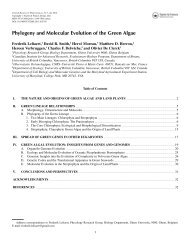The red algal genus Reticulocaulis from the Arabian
The red algal genus Reticulocaulis from the Arabian
The red algal genus Reticulocaulis from the Arabian
Create successful ePaper yourself
Turn your PDF publications into a flip-book with our unique Google optimized e-Paper software.
Schils et al.: <strong>Reticulocaulis</strong> in <strong>the</strong> Indian Ocean 49<br />
Figs 16–20. <strong>Reticulocaulis</strong> mucosissimus. Cystocarpic and spermatangial features. (MAS 138). cfc, cortical filament cell; cp, carpogonium; cs,<br />
carposporangium; gc, gonimoblast cell; gi, gonimoblast initial; hy, hypogynous cell; nc, nutritive cell; sp, spermatangium; spm, spermatangial<br />
mo<strong>the</strong>r cell; tri, trichogyne. Scale bars 10 m.<br />
Fig. 16. Division of <strong>the</strong> (presumably fertilized) carpogonium to produce <strong>the</strong> gonimoblast initial. Nutritive-cell filaments are borne on <strong>the</strong><br />
hypogynous cell, and <strong>the</strong> trichogyne is still attached to <strong>the</strong> carpogonium.<br />
Fig. 17. Fusion of <strong>the</strong> nutritive-cell clusters with <strong>the</strong> hypogynous cell through primary pit connections (arrowhead), in which <strong>the</strong> pit plugs<br />
progressively break down (arrows), resulting in broad open passageways. Gonimoblast cells are larger and more angular than nutritive cells<br />
and abut <strong>the</strong> clusters next to <strong>the</strong> remnant trychogyne.<br />
Fig. 18. Ovoid terminal carposporangia borne on angular penultimate cells of branched gonimoblast filaments.<br />
Fig. 19. Spermatangia forming in dendroid clusters on one of a pair of ultimate branches of a cortical filament, <strong>the</strong> cells of <strong>the</strong> second branch<br />
remaining sterile.<br />
Fig. 20. Detail of a dendroid spermatangial cluster: <strong>the</strong> spermatangia are borne mostly in pairs on subterminal mo<strong>the</strong>r cells.<br />
by rhizoidal filaments. <strong>The</strong> rhizoidal filaments develop <strong>from</strong><br />
periaxial cells and o<strong>the</strong>r jacket cells; <strong>the</strong>y branch (Fig. 28),<br />
and some initiate secondary cortical filaments (Figs 22, 27,<br />
28).<br />
<strong>The</strong> rhodoplasts are discoid, have a distinctive ‘erythrocyte’<br />
appearance (Fig. 29), and are 2–4 m in diameter. As in R.<br />
mucosissimus, <strong>the</strong> rhizoidal and jacket cells contain fewer rhodoplasts<br />
than do <strong>the</strong> cortical cells, and older axial cells virtually<br />
lack <strong>the</strong>m altoge<strong>the</strong>r.<br />
<strong>The</strong> gametophytes are monoecious. Spermatangia develop<br />
on terminal (Fig. 25) and subterminal cortical cells, with up<br />
to nine fertile axial cells forming in series (Fig. 30). Unlike<br />
in R. mucosissimus, <strong>the</strong> spermatangia tend to be borne directly<br />
on fertile axial cells ra<strong>the</strong>r than on terminal mo<strong>the</strong>r cells of<br />
dendroid cortical filaments. Carpogonial branches are scatte<strong>red</strong><br />
throughout <strong>the</strong> thallus in various states of development.<br />
<strong>The</strong> carpogonial branch is 7–13 cells long, <strong>the</strong> supporting cell<br />
being one of <strong>the</strong> periaxial cells, a jacket cell (rhizoidal fila-

















